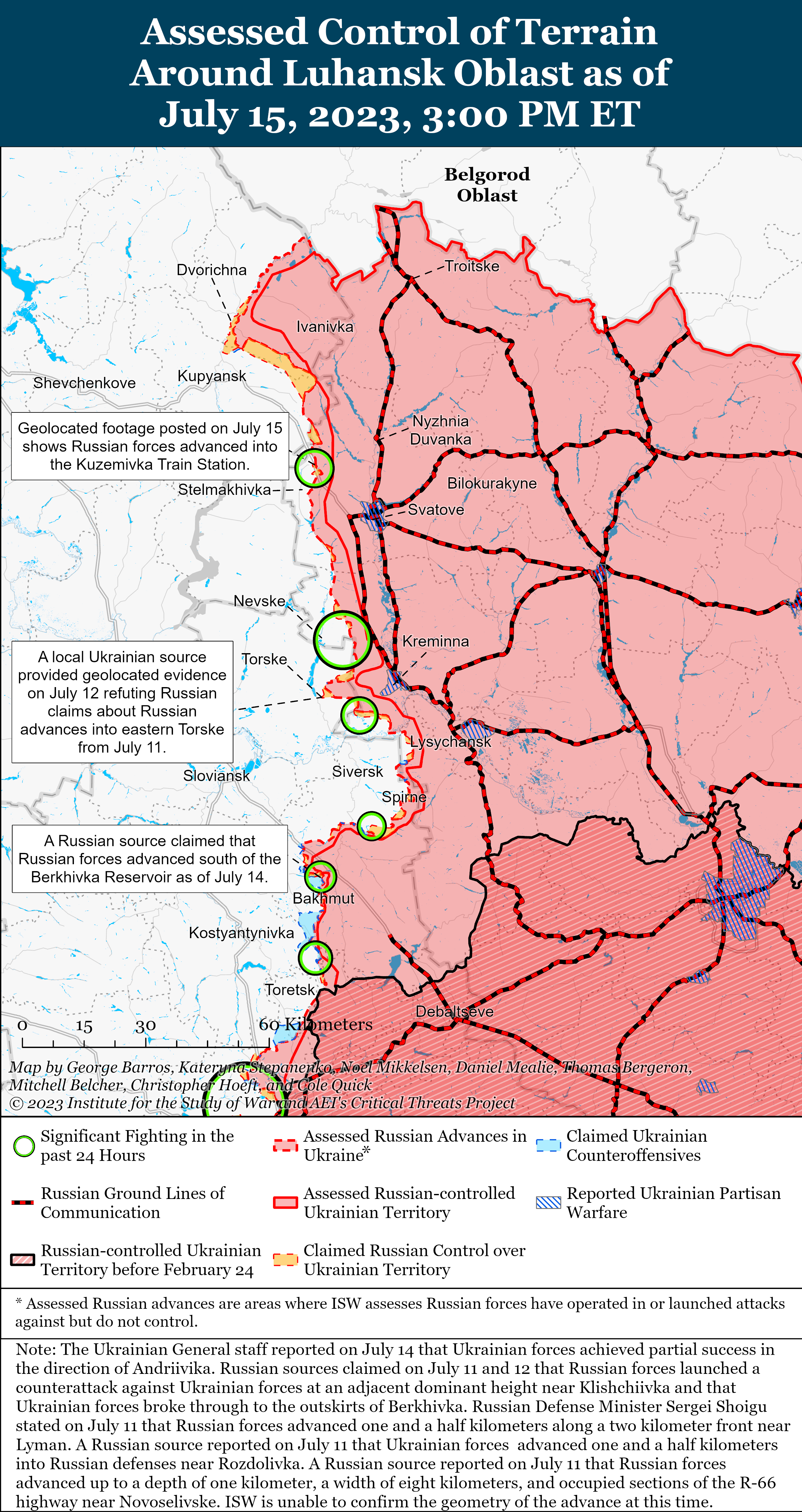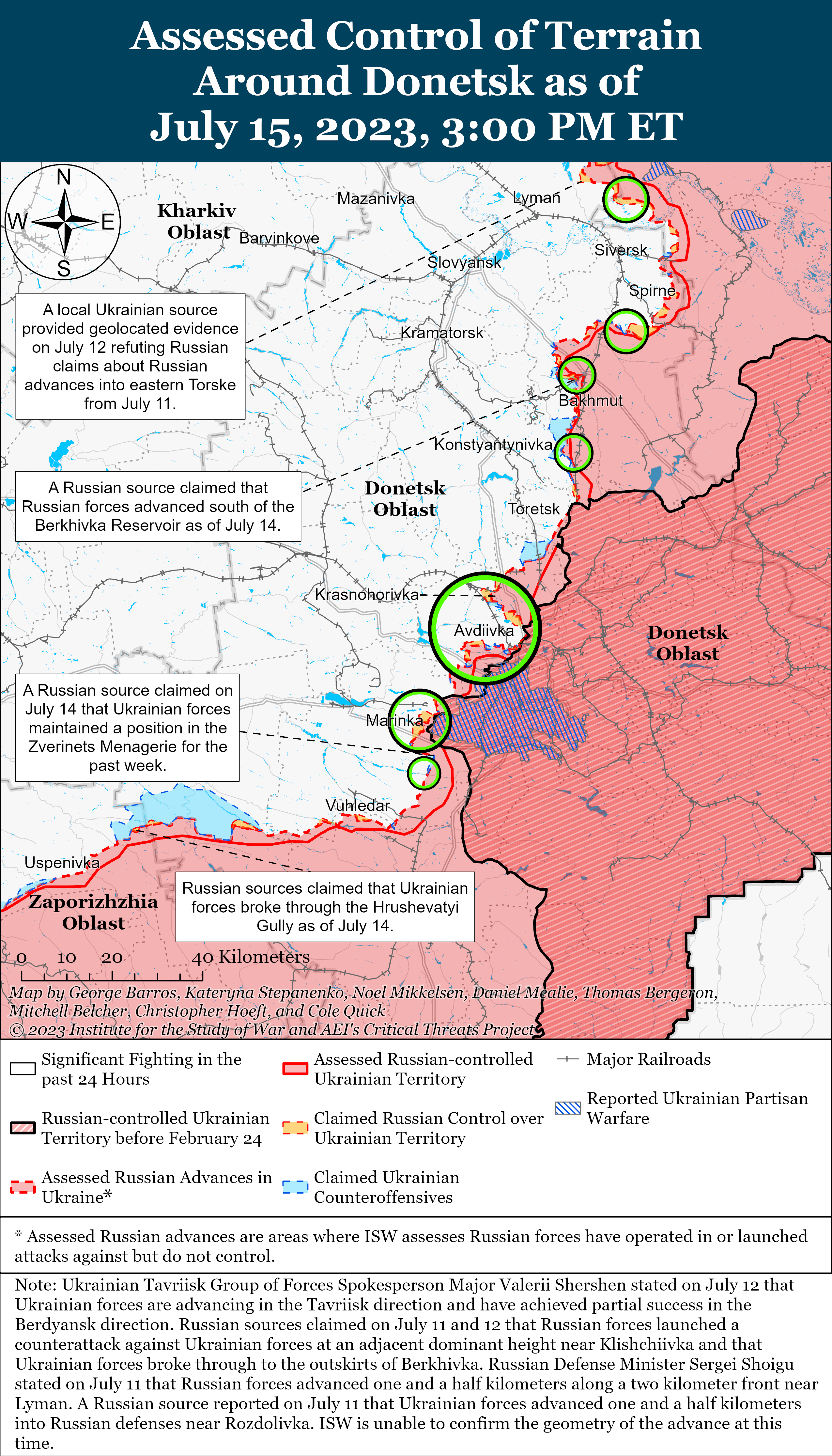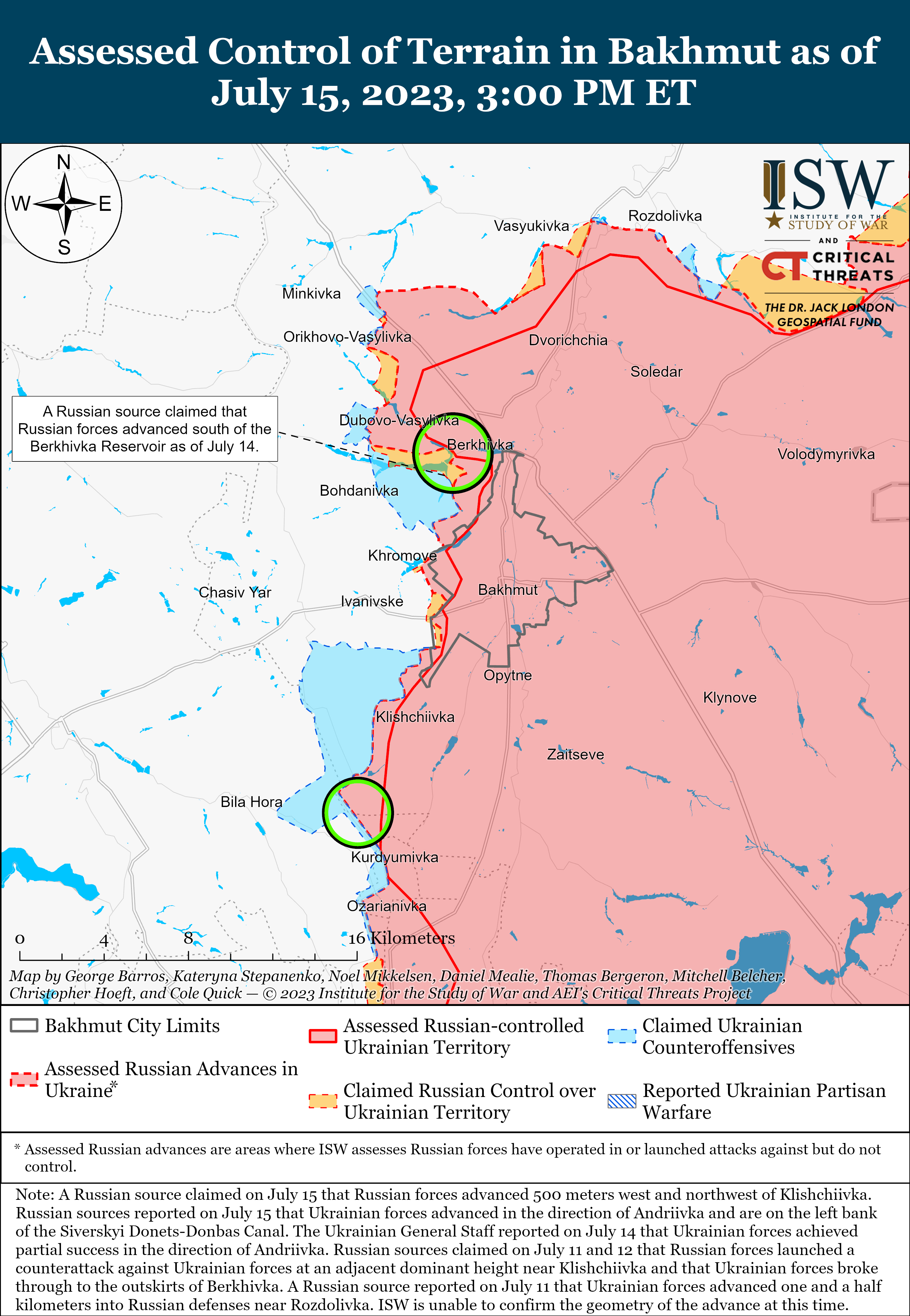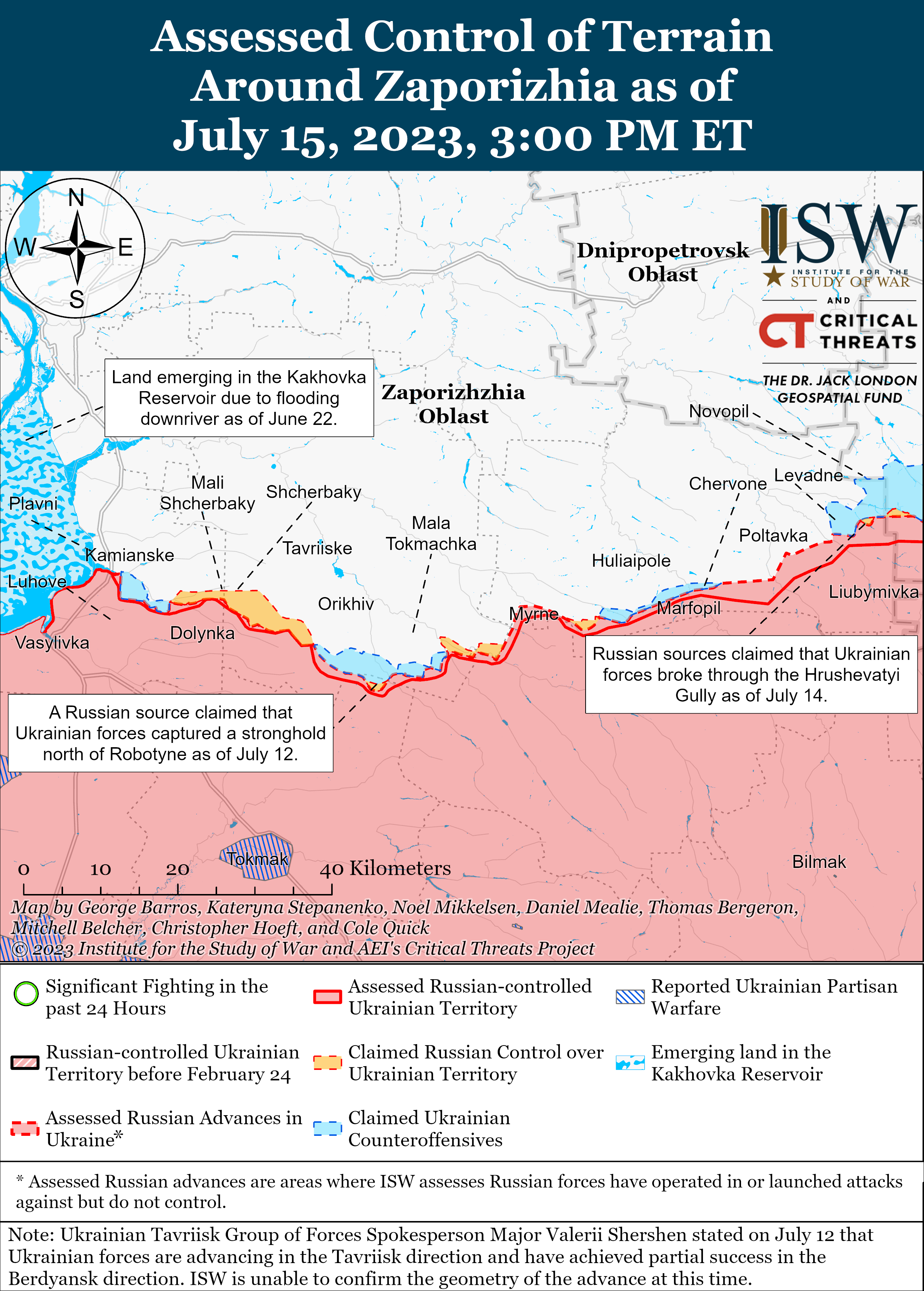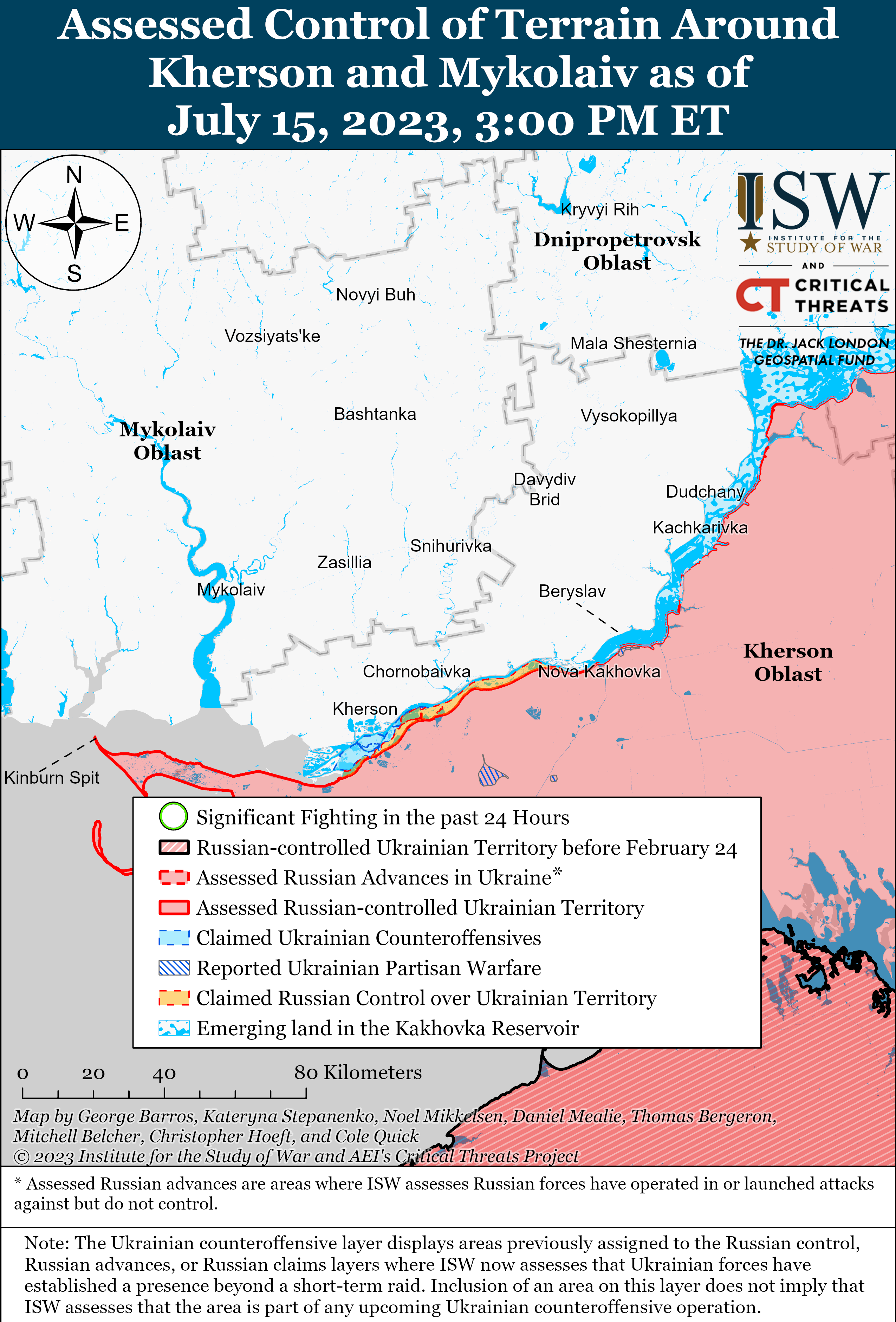 |
 |
Russian Offensive Campaign Assessment, July 15, 2023

Russian Offensive Campaign Assessment, July 15, 2023
Riley Bailey, Kateryna Stepanenko, Nicole Wolkov, Angelica Evans, and Frederick W. Kagan
July 15, 2023, 8pm ET
Click here to see ISW’s interactive map of the Russian invasion of Ukraine. This map is updated daily alongside the static maps present in this report.
Click here to access ISW’s archive of interactive time-lapse maps of the Russian invasion of Ukraine. These maps complement the static control-of-terrain map that ISW produces daily by showing a dynamic frontline. ISW will update this time-lapse map archive monthly.
Note: The data cutoff for this product was 1:00pm ET on July 15. ISW will cover subsequent reports in the July 16 Russian Offensive Campaign Assessment.
[Correction: ISW's July 15 assessment misrepresented a report from The New York Times (NYT). The NYT reported that Russian forces destroyed or damaged in the first two weeks of Ukraine’s counteroffensive 20 percent of Ukraine’s deployed weaponry, including Western-provided equipment and equipment that Ukraine already had, and not, as our July 15 assessment erroneously reported, that “Russian forces destroyed up to 20 percent of Ukraine’s Western-provided weaponry in the first two weeks of the counteroffensive." The July 15 assessment is not impacted by this error and remains unchanged. ISW apologizes for this mistake.]
Russian sources reported on July 15 that the Russian military command dismissed 106th Guards Airborne (VDV) Division Commander Major General Vladimir Seliverstov.[1] Russian sources stated that the reason for Seliverstov’s dismissal is currently unknown but speculated that it could be associated with Seliverstov’s reputation for speaking up on behalf of his soldiers.[2] Russian sources claimed that the 106th VDV Division has been operating in the Bakhmut area since January, and ISW has recently observed the 106th VDV Division’s 137th Guards VDV Regiment defending against Ukrainian counteroffensive operations on Bakhmut’s northern flank.[3] A Russian milblogger has claimed that elements of the 106th VDV Division are also supporting Russian defensive operations south of Bakhmut.[4] Relatives of mobilized personnel serving in the 137th VDV Regiment notably appealed to Russian President Vladimir Putin, Tula Oblast Governor Alexei Dyumin, and Russian Defense Minister Sergei Shoigu in April about poor conditions and lack of supplies in the unit.[5] Vocal discontent about conditions in areas where Russian forces are defending against Ukrainian counteroffensive operations may have prompted Seliverstov to appeal to the Russian military command, which may have contributed to his dismissal. ISW has not observed confirmation of Seliverstov’s dismissal, but Russian reporting about the dismissal follows a pattern similar to that of previous claims of command changes that have proven true.[6]
Seliverstov’s dismissal may be a part of an ongoing purge of insubordinate commanders by the Russian military command and may suggest that the corrosion of the Russian chain of command in Ukraine is accelerating. The Russian military command recently dismissed 58th Combined Arms Army (Southern Military District) Commander Major General Ivan Popov after he reportedly attempted to bypass Chief of the Russian General Staff and overall theater commander Army General Valery Gerasimov and bring his complaints about the situation in western Zaporizhia Oblast directly to Putin.[7] Popov’s complaints reportedly centered on a lack of rotations for his troops, and in a leaked audio message Popov also complained about heavy losses and a lack of effective counterbattery capabilities.[8] These issues are likely impacting Russian forces throughout the theater in Ukraine, and reports of Seliverstov’s dismissal only four days after reports of Popov’s dismissal suggest that the Russian command may have fired Seliverstov for similar reasons.[9] ISW assessed that Popov’s insubordination is indicative of a pattern of behavior that has developed within the Russian command in Ukraine, in which commanders have challenged the authority of senior commanders and sought to use their responsibility for key sectors of the front to cajole the Kremlin to support them.[10]
Endemic problems within the Russian war effort in Ukraine, exacerbated by poor decisions made by senior political and military leaders, are likely prompting strong-willed commanders to challenge their senior commanders in efforts to preserve their forces and lead combat effective units.[11] The 58th Combined Arms Army‘s (CAA) and the 106th VDV Division’s relatively effective defense against Ukrainian counteroffensive operations in their respective areas of the front thus far suggests that they are some of the most combat effective formations committed to the frontline, and Popov and Seliverstov likely contributed to their relative effectiveness by being willing to challenge superiors and the system. Popov’s reported actions clearly crossed the line to insubordination. Seliverstov may have followed Popov’s example or the Russian military leadership may have dismissed Seliverstov out of the fear that he would do so.
Seliverstov’s dismissal suggests that there is a deep concern within the Russian military leadership about the chain of command in Ukraine. Popov’s, Russian VDV Commander Colonel General Mikhail Teplinsky’s, and Wagner Group financier Yevgeny Prigozhin’s challenges to Gerasimov’s and Shoigu’s authority have established a precedent for insubordination that can hollow out support for the Russian military command among senior officers.[12] ”Vostok“ Battalion Commander Alexander Khodakovsky, who leads forces defending against Ukrainian counteroffensives in western Donetsk Oblast, amplified Popov’s complaints about the lack of Russian counterbattery capabilities on July 15, suggesting that the controversy with Popov’s dismissal may be influencing other commanders to more publicly voice their frustrations.[13] The apparently intensifying pattern of insubordination may prompt the Russian military leadership to replace commanders whom they perceive to be potentially insubordinate with loyal figures, preferring yes-men to competent and strong-willed officers able to maintain the combat capabilities of Russian formations defending in key sectors of the front in Ukraine.
The Russian military leadership is likely attempting to dissuade commanders from emulating recent cases of insubordination by punishing those involved in leaking Popov’s message of complaints. Shoigu is also likely attempting to mitigate the aftermath of Popov’s leaked audio recording within the Russian government and punish Russian State Duma Deputy and former Deputy Commander of the Southern Military District (SMD) Lieutenant General Andrei Gurulev for the leak. Russian sources speculated that Shoigu is demanding that the Russian State Duma Defense Committee expel Gurulev for leaking Popov’s audio message.[14] A Russian source close to Russian security officials claimed that the United Russia party is preparing a set of punishments that will include censoring Gurulev from discussing Russia’s invasion of Ukraine.[15] One source claimed that Gurulev’s fate in the State Duma depends on an upcoming meeting between Secretary of the General Council of United Russia Party Andrey Turchak and Shoigu.[16] Turchak previously publicly accused Gurulev of leaking the audio recording to stage a ”political show.”[17] Another source claimed that Gurlev was summoned to meet with Chairman of the Russian State Duma Vyacheslav Volodin on July 17.[18]
Growing insubordination will likely exacerbate existing factional divides within the Russian military and the wider Russian security sphere. A Russian source claimed that Dyumin unsuccessfully attempted to intercede to prevent Seliverstov’s dismissal in a trip to Moscow on July 14.[19] Dyumin may have been advocating for Seliverstov in opposition to Shoigu and Gerasimov or simply because the 106th VDV Division is headquartered in Tula Oblast. In either case Dyumin‘s intervention likely inflamed perceptions within the Russian military that the dismissal was associated with factionalism. Gerasimov and Shoigu may view Dyumin as an anti-MoD establishment figure due to his reported affiliations with Prigozhin, his reported involvement in negotiations that brought Wagner’s rebellion to an end, and widespread rumors following the rebellion that Dyumin would replace Shoigu as defense minister.[20] Shoigu and Gerasimov may also view insubordination within the VDV as the result of factionalism since Teplinsky is now the highest profile anti-Gerasimov officer following Prigozhin’s apparent denouement.[21] Russian sources notably claimed that the 106th VDV Division closely operated alongside Wagner forces in January 2023 as their offensive on Bakhmut intensified, and Gerasimov and his affiliates may view Seliverstov as an officer in a hostile camp due to his relationships with both Wagner and Teplinsky.[22] Russian forces also claimed that Seliverstov routinely opposed the command of former VDV commander and close Gerasimov affiliate Colonel General Andrey Serdyukov during the Russian offensive on Kyiv in the early stages of the full-scale invasion and may have established himself as a noted anti-Gerasimov commander at that time, since Serdyukov was in Gerasimov’s patronage.[23] Teplinsky’s and Prigozhin’s challenges to Gerasimov and Shoigu likely engendered a view within the MoD establishment that acts of insubordination are likely also factional power plays aimed at weakening their support with the Kremlin.[24] Gerasimov and Shoigu may increasingly view opposition to their decisions as evidence of factionalism and may use perceived factional affiliations as grounds for punishing or firing those they view as presenting a threat of insubordination.
Factions within the Russian security forces and the Kremlin appear to be fighting for control over the Russian insider information space. Russian insider Telegram channels routinely speculate on internal Kremlin and Russian Ministry of Defense (MoD) politics and dynamics between Russian political factions. Russian authorities arrested on July 14 former Russian Federal Security Service (FSB) officer Colonel Mikhail Polyakov, who reportedly ran several popular insider Telegram channels.[25] A Russian source claimed that Polyakov previously served as the head of the Moscow FSB service for the protection of the constitutional order.[26] Russian insider sources claimed that Polyakov was in frequent contact with the Russian MoD’s Department of Military Representatives and used his affiliation with the FSB to advance his personal unspecified objectives - possibly using secret information to defame Russian officials.[27] One source claimed that Polyakov was involved in distributing Popov’s leaked audio recording.[28] An insider source also claimed that the recent arrest of Russian Deputy Minister for Digital Development Maxim Parshin for bribery was also related to inter-Kremlin fight for control over the online information space and noted that Presidential Administration officials such as First Deputy Chief of Staff of the Russian Presidential Administration Sergey Kiriyenko also controls a number of Telegram channels.[29] One source sarcastically observed that the FSB has moved from controlling Russia to fighting for control over Telegram, while another noted that Polyakov’s arrest may be the start of a fight for control over insider sources on the Russian internet.[30]
Polyakov’s arrest suggests that different factions within the Kremlin and Russian security entities are exploiting the Russian information space and secret information to advance their political and financial objectives against the backdrop of Russia’s war in Ukraine. If Polyakov’s affiliation with numerous insider Telegram channels is true, then it is evident that Russian officials see the Russian information space as an important source of authority that allows them to promote their interests and discredit their opponents in the eyes of their constituencies. One Russian source, for example, rhetorically asked who would want to discredit the FSB via Polyakov’s arrest, while another milblogger observed that such infighting was not as evident prior to 2022.[31] Wagner Group financier Yevgeny Prigozhin’s mutiny may also have impelled Russian officials to seek to discredit or eliminate opponents who control some of the insider Telegram sources to maintain their standings or positions.
Ukrainian forces conducted counteroffensive operations on at least three sectors of the front on June 15 and reportedly made limited gains. Russian sources claimed that Ukrainian forces made limited gains south of Bakhmut near Andriivka (10km south of Bakhmut) and crossed the Siverskyi Donetsk Canal in the area.[32] Russian sources also claimed that Ukrainian forces made limited advances in the western Donetsk-eastern Zaporizhia Oblast border area southwest of Velyka Novosilka and in western Zaporizhia Oblast northeast of Robotyne (12km south of Orikhiv).[33] A Russian milblogger claimed that Russian forces are ”constantly” moving reinforcements to the Bakhmut area and recently transferred an unspecified BARS (Russian Combat Reserve) unit from the Kreminna area to near Klishchiivka (7km southwest of Bakhmut), indicating that Ukrainian counteroffensive operations continue to trigger transfers of Russian forces to the Bakhmut area.[34] Ukrainian Tavriisk Group of Forces Commander Brigadier General Oleksandr Tarnavskyi stated in an interview with CNN published on July 14 that the counteroffensive is successful but acknowledged that the tempo of Ukrainian advances is slower than expected.[35] Tarnavskyi stated that Ukrainian forces are effectively defeating Russian forces at longer distances, likely referencing Ukraine’s continued interdiction campaigns in eastern and southern Ukraine.[36] Tarnavskyi also reported that Ukrainian forces received cluster munitions that can ”radically change [the battlefield]” and have yet to use them.[37]
The New York Times (NYT) reported that the Ukrainian military has adjusted its strategy to minimize Ukrainian casualties while continuing to attrit Russian forces, supporting ISW’s previous assessments. NYT reported that unnamed US and European officials estimated that Russian forces destroyed up to 20 percent of Ukraine’s Western-provided weaponry in the first two weeks of the counteroffensive.[38] The NYT reported that officials stated that the rate of losses has dropped to 10 percent in the subsequent weeks due to a change in Ukrainian strategy.[39] The NYT reported that the Ukrainian military has changed tactics to focus on wearing down Russian forces with artillery and long-range missiles instead of large-scale assaults, which is consistent with Ukrainian Commander-in-Chief General Valerii Zaluzhnyi’s statement on July 14 that increased Ukrainian indirect fire can both pin down Russian forces and minimize Ukrainian casualties.[40] ISW previously assessed on July 4 that Ukrainian forces appear to be focusing on creating an asymmetrical attrition gradient that conserves Ukrainian manpower at the cost of a slower rate of territorial gains, while gradually wearing down Russian manpower and equipment.[41] Ukraine‘s military has likely been refining its counteroffensive strategy for weeks, and the larger effects of those adjustments are only just becoming clear to some observers. Ukraine will likely continue to adjust its strategy and execution throughout the counteroffensive to facilitate continued progress.
The Belarusian Ministry of Defense (MoD) announced that it developed a plan for Wagner Group personnel to train Belarusian forces as Ukrainian, Russian, and Belarusian sources continue to report that Wagner forces are moving to Belarus. The Belarusian MoD announced on July 14 that it developed a roadmap with ”Wagner leadership” for Wagner forces to train Belarusian forces and pledged to provide additional information about the plan.[42] Independent Belarusian monitoring group The Hajun Project reported that an anonymous source observed Belarusian traffic police escorting a convoy consisting of at least 60 vehicles with Donetsk and Luhansk People’s Republics’ license plates in Belarus on the morning of July 15.[43] The Hajun Project stated that the convoy was likely transferring Wagner personnel from Russia to Belarus and may be en route to a tent camp in Tsel (15km northwest of Aspovichy), Mogilev Oblast.[44] The Ukrainian Resistance Center reported that Belarusian partisans confirmed that 240 Wagner personnel, 40 trucks, and a large number of weapons arrived in Aspovichy and that Wagner forces are staying in Tsel, Mogilev Oblast.[45] Several milbloggers also posted footage and photos claiming to show a convoy of Wagner vehicles en route to Belarus.[46] It is unclear if a single Wagner convoy traveled from Russia to Belarus or if multiple conveys are en route to Belarus at this time.
Russian authorities likely continue to forcibly integrate Ukrainian Orthodox Church (UOC) dioceses into the Kremlin-controlled Russian Orthodox Church (ROC) as part of a wider religious persecution campaign in occupied Ukraine. Luhansk People's Republic (LNR) Head Leonid Pasechnik announced on July 15 the incorporation of the Luhansk, Alchevsk, Severodonetsk, Starobilsk, and Rovenky UOC dioceses into the ROC.[47] The ROC has already seized the Berdyansk and Prymorsk dioceses in occupied Zaporizhia Oblast, and a Russian news aggregator claimed that the Russian Ministry of Justice recently registered the Donetsk City and Horlivka dioceses as part of the ROC.[48] The new round of forced integration of the UOC dioceses in occupied Luhansk Oblast followed a Ukrainian court ruling that the Head of the Kyiv-Pechersk Lavra Metropolitan Pavel will go to a detention center instead of remaining under house arrest.[49] Russian sources attempted to portray the integration of UOC dioceses into the ROC as a response to claimed Ukrainian religious suppression of a Kremlin-run ROC. The ROC has explicit links to the Kremlin and has provided material and spiritual support to Russia during the war.[50] This explanation makes little sense, however, as the ROC clearly faces no threats from the Ukrainian government in Russian-occupied territory. The Ukrainian government is not engaging in religious suppression, moreover, but rather acting against religious elements it asserts are linked to the Kremlin’s war effort.[51] Russian authorities have conducted systematic religious persecution in occupied Ukraine since the start of the war, however.[52]
Key Takeaways:
- Russian sources reported on July 15 that the Russian military command dismissed 106th Guards Airborne (VDV) Division Commander Major General Vladimir Seliverstov.
- Seliverstov’s dismissal may be a part of an ongoing purge of insubordinate commanders by the Russian military command and may suggest that the corrosion of the Russian chain of command in Ukraine is accelerating.
- The Russian military leadership is likely attempting to dissuade commanders from emulating recent cases of insubordination by punishing those involved in leaking Popov’s message of complaints.
- Growing insubordination will likely exacerbate existing factional divides within the Russian military and the wider Russian security sphere.
- Factions within the Russian security forces and the Kremlin appear to be fighting for control over the Russian insider information space.
- Polyakov’s arrest suggests that different factions within the Kremlin and Russian security entities are exploiting the Russian information space and secret information to advance their political and financial objectives against the backdrop of Russia’s war in Ukraine.
- Ukrainian forces conducted counteroffensive operations on at least three sectors of the front on June 15 and reportedly made limited gains.
- The New York Times (NYT) reported that the Ukrainian military has adjusted its strategy to minimize Ukrainian casualties while continuing to attrit Russian forces, supporting ISW’s previous assessments.
- The Belarusian Ministry of Defense (MoD) announced that it developed a plan for Wagner Group personnel to train Belarusian forces as Ukrainian, Russian, and Belarusian sources continue to report that Wagner forces are moving to Belarus.
- Russian authorities likely continue to forcibly integrate Ukrainian Orthodox Church (UOC) dioceses into the Kremlin-controlled Russian Orthodox Church (ROC) as part of a wider religious persecution campaign in occupied Ukraine.
- Russian forces conducted offensive operations and made limited territorial gains near Svatove.
- Ukrainian forces reportedly made limited territorial gains on Bakhmut’s southern flank, while Russian sources claimed that Russian forces made limited advances on Bakhmut’s northern and southern flanks.
- Russian forces continued limited offensive operations on the Donetsk City-Avdiivka line but did not make any territorial gains.
- Ukrainian forces continued counteroffensive operations along the western Donetsk-eastern Zaporizhia Oblast border and reportedly made limited gains.
- Ukrainian forces continued counteroffensive operations and reportedly made limited advances in western Zaporizhia Oblast.
- The Russian Ministry of Defense (MoD) announced the completion of Russia’s spring 2023 conscription cycle on July 15.
- The Ukrainian Resistance Center reported that the Kremlin launched a program to recruit young adults in Russia for service in occupation administrations in Ukraine.
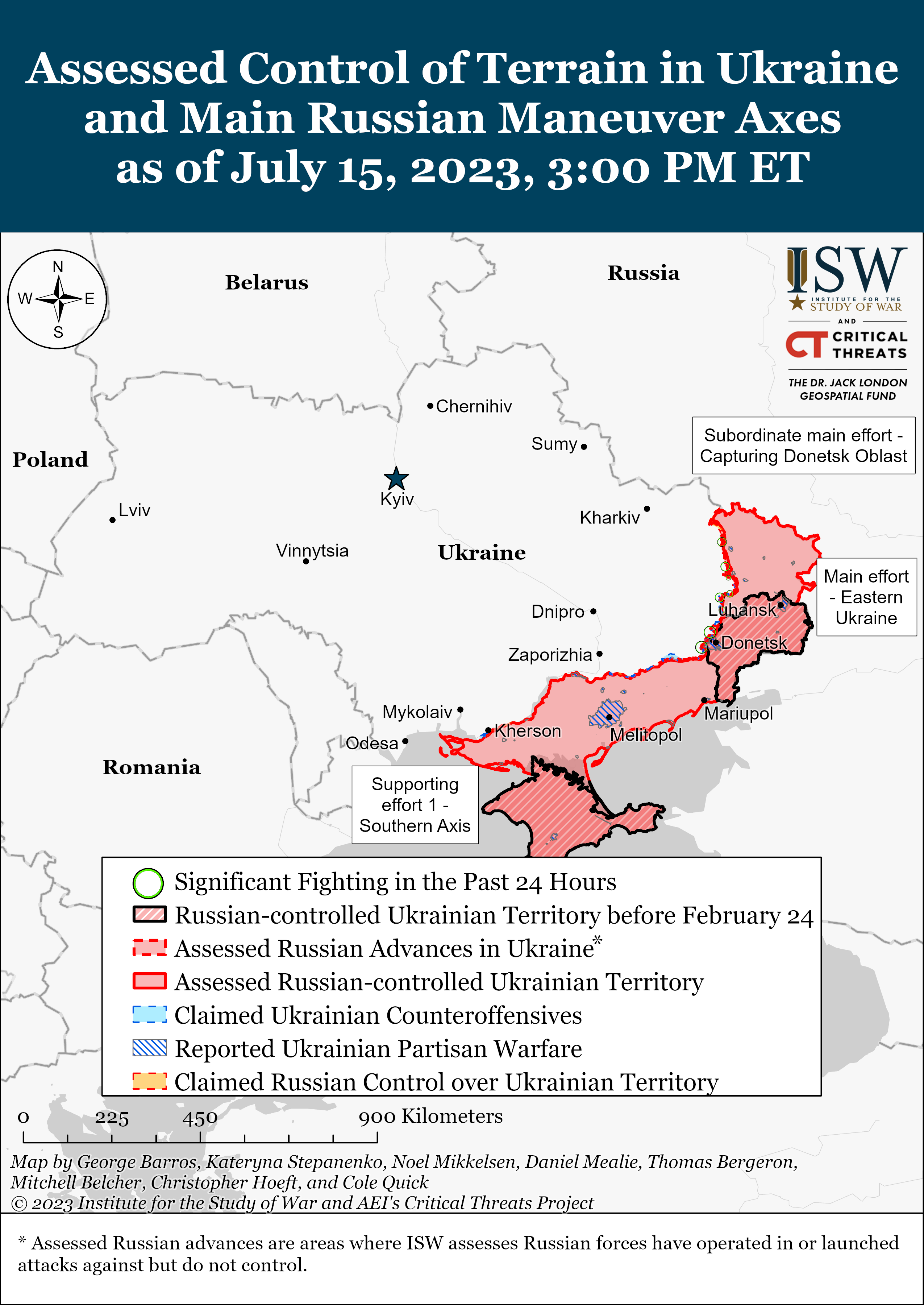
We do not report in detail on Russian war crimes because these activities are well-covered in Western media and do not directly affect the military operations we are assessing and forecasting. We will continue to evaluate and report on the effects of these criminal activities on the Ukrainian military and the Ukrainian population and specifically on combat in Ukrainian urban areas. We utterly condemn these Russian violations of the laws of armed conflict, Geneva Conventions, and humanity even though we do not describe them in these reports.
- Russian Main Effort – Eastern Ukraine (comprised of two subordinate main efforts)
- Russian Subordinate Main Effort #1 – Capture the remainder of Luhansk Oblast and push westward into eastern Kharkiv Oblast and encircle northern Donetsk Oblast
- Russian Subordinate Main Effort #2 – Capture the entirety of Donetsk Oblast
- Russian Supporting Effort – Southern Axis
- Russian Mobilization and Force Generation Efforts
- Activities in Russian-occupied areas
Russian Main Effort – Eastern Ukraine
Russian Subordinate Main Effort #1 – Luhansk Oblast (Russian objective: Capture the remainder of Luhansk Oblast and push westward into eastern Kharkiv Oblast and northern Donetsk Oblast)
Russian forces conducted offensive operations and made limited territorial gains near Svatove on July 15. Geolocated footage published on July 15 shows that unspecified Russian infantry advanced slightly in Novoselivske (16km northwest of Svatove) and hold entrenched positions along the railroad near the settlement.[53] The Ukrainian General Staff reported that Russian forces conducted unsuccessful offensive operations south of Novoselivske.[54] A Kremlin-affiliated milblogger reported that Russian forces are also trying to seize a tactical height near Novoselivske and clear Ukrainian forces from the forests south of the settlement.[55] The milblogger claimed that neither Russian nor Ukrainian forces control Novoselivske and that movement in the settlement is difficult due to a lack of shelter and Ukrainian drone activity.[56] The milblogger also claimed that Russian artillery elements of the 21st Separate Guards Motorized Rifle Brigade (2nd Combined Arms Army, Central Military District) stopped a Ukrainian attack near Kuzemivka (16km northwest of Svatove).[57] Ukrainian Eastern Group of Forces Spokesperson Colonel Serhiy Cherevaty reported that Russian forces are most active in the Kupyansk and Lyman directions.[58]
A Russian source claimed that Ukrainian forces conducted offensive operations near Kreminna and did not make any advances in the area on July 15. A Kremlin-affiliated milblogger claimed that a Ukrainian sabotage and reconnaissance group attempted to break through Russian defensive lines towards Dibrova (6km southwest of Kreminna) from the Serebryanske forest area (10km south of Kreminna).[59] The milblogger also claimed that Ukrainian forces continued offensive operations in the forests west of Kreminna.[60]
Russian forces conducted offensive operations near Kreminna and reportedly made limited territorial gains on July 15. The Ukrainian General Staff and Cherevaty reported that Russian forces conducted unsuccessful offensive operations east of Novosadove (17km northwest of Kreminna), west of Dibrova, and east of Vesele (30km south of Kreminna) .[61] The Russian Ministry of Defense (MoD) claimed that Russian forces repelled two Ukrainian attacks near Makiivka (22km northwest of Kreminna) and Torske (15km west of Kreminna).[62] A Russian milblogger claimed that Russian forces advanced near Torske and in the forests near Kreminna.[63] A Kremlin-affiliated milblogger claimed that Russian forces advanced towards Yampolivka (17km west of Kreminna) but that there is currently no reliable information on the control of terrain around Torske.[64] Another milblogger posted footage claiming to show elements of the Russian 228th Mechanized Infantry Regiment (90th Tank Division, 41st Combined Arms Army, Central Military District) along with unspecified elements of a Chechen ”Akhmat” reconnaissance unit assaulting Ukrainian positions near Kreminna.[65]
Russian Subordinate Main Effort #2 – Donetsk Oblast (Russian Objective: Capture the entirety of Donetsk Oblast, the claimed territory of Russia’s proxies in Donbas)
Ukrainian forces reportedly made limited territorial gains on Bakhmut’s southern flank, as positional battles continued elsewhere along the Bakhmut frontline on July 15. A Kremlin-affiliated milblogger claimed that Ukrainian forces advanced near Andriivka (10km south of Bakhmut) and crossed the Siverskyi Donets-Donbas Canal in the area.[66] Another Russian source claimed that Ukrainian forces advanced in the Kurdyumivka (15km southwest of Bakhmut) direction, while the Russian Ministry of Defense (MoD) also claimed that Russian Southern Group of Forces repelled Ukrainian attacks on Kurdyumivka.[67] Russian sources claimed that Ukrainian forces continued to attack Russian positions near Klishchiivka (7km southwest of Bakhmut) and unsuccessfully attempted to regain positions in the Berkhivka (6km north of Bakhmut) area.[68] The milbloger noted that the situation largely did not change in the Berkhivka and Rozdolivka (16km northeast of Bakhmut) areas, and several Russian milbloggers claimed that intense battles are ongoing in the Klishchiivka area.[69] Ukrainian Eastern Group of Forces Spokesperson Colonel Serhiy Cherevaty observed that Ukrainian forces maintain the initiative on the Bakhmut frontline.[70]
Russian sources claimed that Russian forces made limited advances on Bakhmut’s northern and southern flanks and continued to respond to Ukrainian counteroffensives by committing elite units to defend Bakhmut’s flanks on July 15. A Kremlin-affiliated milblogger claimed that Russian forces successfully counterattacked west and northwest of Klishchiivka and recaptured 500 meters of territory.[71] The Ukrainian General Staff reported that Russian forces unsuccessfully launched assaults southwest of Andriivka and in the Berkhivka area.[72] A Kremlin-affiliated milblogger claimed that Russian forces unsuccessfully counterattacked near Berkhivka, and Ukrainian forces were able to retain their positions.[73] A Russian milblogger claimed that Russian forces are constantly sending reinforcements to defend against Ukrainian attacks and have transferred an unspecified BARS (Russian Combat Army Reserve) unit from the Kreminna area to Klishchiivka.[74] Chechen Republic Head Ramzan Kadyrov claimed that elements of the Chechen ”Akhmat” Spetsnaz unit, 364th Special Purpose Brigade, and 4th Motorized Rifle Brigade (2nd Luhansk People’s Republic Army Corps) are operating in the Klishchiivka area.[75] A Russian milblogger indicated that elements of the 364th Special Purpose Brigade are involved in repelling Ukrainian counteroffensives near Klishchiivka.[76] A Kremlin-affiliated milblogger also noted that elements of the Russian 98th Guards Airborne (VDV) Division advanced south of the Berkhivka reservoir on July 13.[77] Russian commitment of numerous VDV and Spetsnaz units north and south of Bakhmut indicates that Ukrainian counteroffensives in the Bakhmut direction are continuing to trigger the deployment of further reinforcements, predominantly from the Luhansk frontline.
Russian forces continued limited offensive operations on the Donetsk City-Avdiivka line but did not make any territorial gains on July 15. The Ukrainian General Staff reported that Russian forces conducted unsuccessful offensive operations in the Pervomaiske (11km west of Avdiivka), Marinka (23km southwest of Donetsk City), and Novomykhailivka (29km southwest of Donetsk City) areas.[78] A Russian news aggregator claimed that Russian forces attacked Ukrainian positions near Novokalynove (12km north of Avdiivka) and southwest of Avdiivka, while positional battles continued in Marinka.[79] A Kremlin-affiliated milblogger claimed that Russian forces conducted unsuccessful attacks on Novomykhaivlivka, Marinka, and Pervomaiske.[80]
Russian Supporting Effort – Southern Axis (Russian objective: Maintain frontline positions and secure rear areas against Ukrainian strikes)
Ukrainian forces continued counteroffensive operations along the western Donetsk-eastern Zaporizha Oblast border and reportedly made limited gains on July 15. A Kremlin-affiliated milblogger claimed that Ukrainian forces gained a foothold near Hrusheva Gully (just south of Rivnopil).[81] The Russian Ministry of Defense (MoD) claimed that Russian forces repelled two Ukrainian attacks near Urozhaine (9km south of Velyka Novosilka).[82] Russian milbloggers claimed that Ukrainian forces conducted attacks northwest of Staromayorske (9km south of Velyka Novosilka) and near Pryyutne (15km southwest of Velyka Novosilka).[83] A milblogger claimed on July 14 that Ukrainian forces conducted attacks near Novodonetske (12km southeast of Velyka Novosilka), Urozhaine, Pryyutne, and Staromayorske.[84] Footage published on July 15 purportedly shows elements of the ”Bezumtsa” Company of the 3rd Motorized Rifle Battalion (60th Separate Motorized Rifle Brigade, 5th Combined Arms Army, Eastern Military District) operating in the Zaporizhia-Donetsk Oblast border area.[85]
Ukrainian forces continued counteroffensive operations and reportedly made limited advances in western Zaporizhia Oblast on July 15. Russian milbloggers claimed that Ukrainian forces made limited advances northeast of Robotyne (12km south of Orikhiv).[86] Zaporizhia Oblast Occupation Administration Head Yevgeny Balitsky claimed that Russian forces repelled two platoon-sized Ukrainian sabotage and reconnaissance groups in the Pyatykhatky (25km southwest of Orikhiv) and Stepove (22km southwest of Orikhiv) directions.[87] A Russian milblogger claimed on July 14 that elements of the 429th Motorized Rifle Regiment (19th Motorized Rifle Division, 58th Combined Arms Army, Southern Military District) repelled Ukrainian attacks near Pyatykhatky-Zherebyanky (up to 27km southwest of Orikhiv).[88] Footage published on July 15 purportedly shows elements of the 70th Motorized Rifle Regiment (42nd Motorized Rifle Division, 58th Combined Arms Army, Southern Military District) operating in the Zaporizhia direction.[89]
Ukrainian forces continue their interdiction campaign in southern Ukraine. Geolocated footage published on July 14 shows a Ukrainian strike on naval infantry elements of the Caspian Flotilla moving in a convoy northwest of Tokmak.[90] Russian sources claimed that Ukrainian forces conducted a missile strike near a railway bridge near Chernihivka in Zaporizhia Oblast.[91]
Russian sources claimed that Ukrainian forces continue to operate on east (left) bank Kherson Oblast near the Antonivsky Bridge and did not claim any Russian or Ukrainian advances in the area. Kherson Oblast Occupation Head Vladimir Saldo claimed that Ukrainian forces continue to hold positions near the Antonivsky Bridge and that Russian forces repel all Ukrainian attempts to cross the Dnipro River.[92] A Kremlin-affiliated milblogger claimed that Russian forces repelled five of six small Ukrainian boats from landing on the east bank of the Dnipro River.[93]
Russian Mobilization and Force Generation Efforts (Russian objective: Expand combat power without conducting general mobilization)
The Russian Ministry of Defense (MoD) announced the completion of Russia’s spring 2023 conscription cycle on July 15.[94] The Russian MoD claimed that the Russian Armed Forces conscripted 147,000 people in accordance with Russian President Vladimir Putin’s March 30 decree.[95] ISW assesses that the Kremlin remains unlikely to deploy newly conscripted personnel to participate in hostilities in Ukraine due to concerns about regime stability.[96] ISW has observed reports of conscripts serving in Russian border oblasts, and the Russian military may be relying on conscripts to fulfill border security roles as a result of the commitment of regular Russian forces to fighting in Ukraine.[97]
Ukrainian Deputy Defense Minister Hanna Malyar reported that the Russian military is forcing mobilized personnel operating in Ukraine to sign military service contracts.[98] Malyar reported on July 15 that Russian commanders blackmail their subordinates and threaten personnel with deployments to frontline positions without rotations to impress mobilized personnel to sign contracts for military service.[99] Malyar added that Russian military leadership is forcing mobilized personnel to sign military service contracts to increase recruitment statistics to appeal to the Kremlin.[100]
The Ukrainian Resistance Center reported on July 15 that “Storm-Z” detachments (composed of prisoner recruits) are increasingly operating in Russian border areas near Belarus and Ukraine. The Resistance Center reported that sources within the Russian Volunteer Corps (RDK) stated that they have observed “Storm-Z" detachments of the 1st Guards Tank Army (Western Military District) arriving in Spiridonov Buda, Bryansk Oblast (20km from the international Ukrainian-Russian border and 5km away from the Belarusian-Russian border).[101] The deployment of these ”Storm-Z’ detachments is likely meant to secure Russian border areas and do not represent preparations to conduct assaults along the northern axis in Ukraine.
Activities in Russian-occupied areas (Russian objective: Consolidate administrative control of annexed areas; forcibly integrate Ukrainian civilians into Russian sociocultural, economic, military, and governance systems)
The Ukrainian Resistance Center reported that the Kremlin launched a program to recruit young adults in Russia for service in occupation administrations in Ukraine.[102] The Resistance Center reported that that the Kremlin’s Department for Internal Policy created the “GisStart” program and that the Russian Federal Youth Agency (Rozmolodezh) is overseeing the program, which invites Russians ages 18 to 35 to participate in “youth councils” and provides internships in occupation structures in Ukraine.[103]
Significant activity in Belarus (Russian efforts to increase its military presence in Belarus and further integrate Belarus into Russian-favorable frameworks).
See topline text.
ISW will continue to report daily observed Russian and Belarusian military activity in Belarus, as part of ongoing Kremlin efforts to increase their control over Belarus and other Russian actions in Belarus.
Note: ISW does not receive any classified material from any source, uses only publicly available information, and draws extensively on Russian, Ukrainian, and Western reporting and social media as well as commercially available satellite imagery and other geospatial data as the basis for these reports. References to all sources used are provided in the endnotes of each update.
[1] https://t.me/milinfolive/103595; https://t.me/istories_media/3047; https://t.me/astrapress/32547; https://t.me/sotaproject/62949 ; https://t.me/vchkogpu/39958
[2] https://t.me/milinfolive/103595; https://t.me/vchkogpu/39958 ; https://t.me/istories_media/3047; https://t.me/astrapress/32547; https://t.me/sotaproject/62949
[3] https://isw.pub/UkrWar070123 ; https://t.me/milinfolive/103595; https://t.me/istories_media/3047; https://t.me/astrapress/32547; https://t.me/sotaproject/62949 ; https://t.me/vchkogpu/39958
[5] https://www.understandingwar.org/backgrounder/russian-offensive-campaign-assessment-april-11-2023
[7] https://isw.pub/UkrWar071323
[8] https://isw.pub/UkrWar071323
[9] https://www.understandingwar.org/backgrounder/russian-offensive-campaign-assessment-july-11-2023 ; https://isw.pub/UkrWar071323
[10] https://isw.pub/UkrWar071323
[11] https://isw.pub/UkrWar071323
[12] https://isw.pub/UkrWar071323
[14] https://t.me/vchkogpu/39957 ; https://t.me/rusbrief/136397; https://t.me/rusbrief/136524
[15] https://t.me/vchkogpu/39957
[16] https://t.me/vchkogpu/39957
[17] https://t.me/turchak_andrey/1346 ; https://t.me/NeoficialniyBeZsonoV/27434 ; https://t.me/boris_rozhin/91975 ; https://t.me/dva_majors/20991 ; https://t.me/vysokygovorit/12246 ; https://t.me/bbcrussian/49320
[20] https://www.understandingwar.org/backgrounder/russian-offensive-campaign-assessment-june-26-2023 ; https://t.me/svobodnieslova/2292 ; https://t.me/Kalyyugatoday/126784 ; https://t.me/z_arhiv/22728 ; https://kirov-portal dot ru/news/vopros-otvet/kto-takoj-dyumin-kotoryj-mozhet-zanyat-post-ministra-oborony-vmesto-shojgu-29547/; https://news.obozrevatel dot com/russia/v-rossii-uzhe-nashli-novogo-ministra-oboronyi-dlya-prigozhina-v-seti-nazvali-imya.htm ; https://t.me/rybar/48996
[22] https://isw.pub/UkrWar052223
[25] https://www.understandingwar.org/backgrounder/russian-offensive-campaign-assessment-july-14-2023
[29] https://t.me/rusbrief/136477
[31] https://t.me/dva_majors/21181
[32] https://t.me/wargonzo/13813;
[34] https://t.me/RVvoenkor/49288
[35] https://t.me/otarnavskiy/164; https://www.cnn.com/2023/07/14/europe/ukraine-us-cluster-munitions-intl/index.html
[36] https://t.me/otarnavskiy/164; https://www.cnn.com/2023/07/14/europe/ukraine-us-cluster-munitions-intl/index.html
[37] https://t.me/otarnavskiy/164; https://www.cnn.com/2023/07/14/europe/ukraine-us-cluster-munitions-intl/index.html
[38] https://www.nytimes.com/2023/07/15/us/politics/ukraine-leopards-bradleys-counteroffensive.html
[39] https://www.nytimes.com/2023/07/15/us/politics/ukraine-leopards-bradleys-counteroffensive.html
[40] https://www.nytimes.com/2023/07/15/us/politics/ukraine-leopards-bradleys-counteroffensive.html ; https://www.washingtonpost.com/world/2023/07/14/ukraine-military-valery-zaluzhny-russia/?utm_source=alert&utm_medium=email&utm_campaign=wp_news_alert_revere&location=alert
[41] https://www.understandingwar.org/backgrounder/russian-offensive-campaign-assessment-july-4-2023
[42] https://t.me/modmilby/29945
[43] https://twitter.com/Hajun_BY/status/1680107430544384000?s=20; https://twitter.com/Hajun_BY/status/1680107432352030720?s=20; https://twitter.com/Hajun_BY/status/1680107668155801600?s=20
[44] https://twitter.com/Hajun_BY/status/1680107430544384000?s=20; https://twitter.com/Hajun_BY/status/1680107432352030720?s=20; https://twitter.com/Hajun_BY/status/1680107668155801600?s=20
[45] https://sprotyv dot mod.gov.ua/pvk-vagner-prodovzhuye-okupatsiyu-bilorusi/
[46] https://t.me/boris_rozhin/92141; https://t.me/okolovoina/32 ; https://t.me/vchkogpu/39952 ; https://t.me/milinfolive/103578
[48] https://t.me/readovkanews/62526; https://www.understandingwar.org/backgrounder/russian-offensive-campaign-assessment-may-17-2023
[49] https://t.me/readovkanews/62551; https://www.rbc dot ru/politics/15/07/2023/64b2868b9a79478284b57904; https://www.kyivpost dot com/post/19483
[50] https://www.understandingwar.org/backgrounder/russian-offensive-campaign-assessment-january-7-2023
[51] https://www.understandingwar.org/backgrounder/russian-offensive-campaign-assessment-january-7-2023
[52] https://www.understandingwar.org/backgrounder/russian-offensive-campaign-assessment-april-9-2023
[53] https://twitter.com/GirkinGirkin/status/1680099404089376768?s=20; https://twitter.com/Arvelleg1/status/1680102860145451011?s=20; https://twitter.com/VigorousFalcon/status/1680169060607336451?s=20; https://t.me/mod_russia/28365
[54] https://www.facebook.com/GeneralStaff.ua/posts/pfbid0R8iM2mR3dvpdoDoYj12BMyvuBEnAAzuRj8HC38bPz9uZEtWtn4333fgD2vY3gDeGl
[58] https://armyinform.com dot ua/2023/07/15/na-bahmutskomu-napryamku-inicziatyva-za-nashymy-sylamy-oborony-na-pivdennomu-ta-pivnichnomu-flangah-sergij-cherevatyj/
[61] https://www.facebook.com/GeneralStaff.ua/posts/pfbid0R8iM2mR3dvpdoDoYj12BMyvuBEnAAzuRj8HC38bPz9uZEtWtn4333fgD2vY3gDeGl ; https://www.facebook.com/GeneralStaff.ua/posts/pfbid0MsZWaWaHs5VdrznA4Jd5hQQLtgPZzgnUX2yAxucqQm2P3rUK4FexRcRqJZdsyDuXl
[69] https://t.me/rusich_army/9948; https://t.me/batalyon15/2279; https://t.me/ok_spn/25696; https://t.me/wargonzo/13813; https://t.me/russkiy_opolchenec/37264
[70] https://armyinform.com dot ua/2023/07/15/na-bahmutskomu-napryamku-inicziatyva-za-nashymy-sylamy-oborony-na-pivdennomu-ta-pivnichnomu-flangah-sergij-cherevatyj/
[72] https://www.facebook.com/GeneralStaff.ua/posts/pfbid0R8iM2mR3dvpdoDoYj12BMyvuBEnAAzuRj8HC38bPz9uZEtWtn4333fgD2vY3gDeGl; https://www.facebook.com/GeneralStaff.ua/posts/pfbid0MsZWaWaHs5VdrznA4Jd5hQQLtgPZzgnUX2yAxucqQm2P3rUK4FexRcRqJZdsyDuXl
[78] https://www.facebook.com/GeneralStaff.ua/posts/pfbid0MsZWaWaHs5VdrznA4Jd5hQQLtgPZzgnUX2yAxucqQm2P3rUK4FexRcRqJZdsyDuXl; https://www.facebook.com/GeneralStaff.ua/posts/pfbid0R8iM2mR3dvpdoDoYj12BMyvuBEnAAzuRj8HC38bPz9uZEtWtn4333fgD2vY3gDeGl
[81] https://t.me/rybar/49717
[82] https://t.me/mod_russia/28366
[85] https://t.me/kommunist/17841 ; https://t.me/voin_dv/3719 ; https://t.me/NeoficialniyBeZsonoV/27521; https://t.me/boris_rozhin/92147 ; https://t.me/epoddubny/16760
[87] https://t.me/BalitskyEV/1314; https://t.me/readovkanews/62540
[88] https://t.me/batalyon15/2279
[89] https://t.me/nm_dnr/10665 ; https://t.me/RtrDonetsk/19083 ; https://t.me/NeoficialniyBeZsonoV/27519 https://t.me/boris_rozhin/92136
[90] https://t.co/l2xl2ujizZ; https://twitter.com/666_mancer/status/1680186616994725890; https://twitter.com/666_mancer/status/1679941668227674113?s=20
[91] https://t.me/readovkanews/62529; https://t.me/vrogov/10944
[92] https://t.me/SALDO_VGA/985
[93] https://t.me/rybar/49712
[94] https://t.me/mod_russia/28363
[95] https://t.me/mod_russia/28363
[96] https://isw.pub/UkrWar033023
[101] https://sprotyv dot mod.gov.ua/shtorm-z-zbilshuye-prysutnist-na-bryanshhyni/
[102] https://sprotyv dot mod.gov.ua/okupanty-zaluchayut-molod-do-roboty-v-okupatsijnyh-administratsiyah/
[103] https://sprotyv dot mod.gov.ua/okupanty-zaluchayut-molod-do-roboty-v-okupatsijnyh-administratsiyah/
